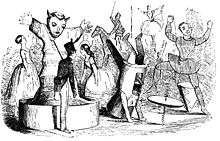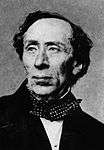The Steadfast Tin Soldier
| "The Steadfast Tin Soldier" | |
|---|---|
| Author | Hans Christian Andersen |
| Original title | "Den Standhaftige Tinsoldat" |
| Country | Denmark |
| Language | Danish |
| Genre(s) | Literary fairy tale |
| Published in | Fairy Tales Told for Children. New Collection. First Booklet. 1838. (Eventyr, fortalte for Børn. Ny Samling. Første Hefte. 1838.) |
| Publication type | Fairy tale collection |
| Publisher | C.A. Reitzel |
| Media type | |
| Publication date | 2 October 1838 |
| Preceded by | "The Daisy" |
| Followed by | "The Wild Swans" |
"The Steadfast Tin Soldier" (Danish: Den standhaftige tinsoldat) is a literary fairy tale by Hans Christian Andersen about a tin soldier's love for a paper ballerina. After several adventures, the tin soldier perishes in a fire with the ballerina. The tale was first published in Copenhagen by C.A. Reitzel on 2 October 1838 in the first booklet of Fairy Tales Told for Children. New Collection. The booklet consists of Andersen's "The Daisy" and "The Wild Swans". The tale was Andersen’s first not based upon a folk tale or a literary model. "The Steadfast Tin Soldier" has been adapted to various media including ballet and animated film.
Plot
On his birthday, a boy receives a set of 25 toy soldiers all cast from one old tin spoon and arrays them on a table top. One soldier stands on a single leg, as having been the last one cast there was not enough metal to make him whole. Nearby, the soldier spies a paper ballerina with a spangle on her sash. She, too, is standing on one leg, and the soldier falls in love. That night, a goblin among the toys in the form of a jack-in-the-box angrily warns the soldier to take his eyes off the ballerina, but the soldier ignores him.
The next day, the soldier falls from a windowsill (presumably the work of the goblin) and lands in the street. Two boys find the soldier, place him in a paper boat, and set him sailing in the gutter. The boat and its passenger wash into a storm drain, where a rat demands the soldier pay a toll.
Sailing on, the boat is washed into a canal, where the tin soldier is swallowed by a fish. When this fish is caught and cut open, the tin soldier finds himself once again on the table top before the ballerina. Inexplicably, the boy throws the tin soldier into the fire. A wind blows the ballerina into the fire with him; she is consumed at once but her spangle remains. The tin soldier melts into the shape of a heart.
Publication
The tale was first published in Copenhagen, Denmark by C. A. Reitzel on 2 October 1838 in Fairy Tales Told for Children. New Collection. First booklet. Other tales in the booklet include "The Daisy" and "The Wild Swans". The tale was republished in collected editions of Andersen's work, first, on 18 December 1849 in Fairy Tales and again on 15 December 1862 in the first volume of Fairy Tales and Stories.[1]
Commentaries

"The Steadfast Tin Soldier" is the first tale Andersen wrote that has neither a literary model nor a folk tale source. It marks a new independence in his writing, and is the zenith of his evocation of the nineteenth century nursery world with its toy dancers, castles, and swans.
Joan G. Haahr writes in The Oxford Companion to Fairy Tales: "The story is unusual among Andersen's early tales, both in its emphasis on sensual desire and in its ambiguities. Blind fate, not intention, determines all events. Moreover, the narrative questions the very decorum it praises. The tin soldier's passive acceptance of whatever happens to him, while exemplifying pietistic ideals of self-denial, also contributes to his doom. Were he to speak and act, the soldier might gain both life and love. Restrained, however, by inhibition and convention, he finds only tragedy and death. The tale is often read autobiographically, with the soldier viewed as symbolizing Andersen's feelings of inadequacy with women, his passive acceptance of bourgeois class attitudes, or his sense of alienation as an artist and an outsider, from full participation in everyday life."[2]
Adaptations

Ub Iwerks did a 1934 Cinecolor cartoon based on the story entitled The Brave Tin Soldier. The cartoon's plot is slightly different from the original story. The antagonist is not a Jack-in-the-Box, but rather a toy king who wants the ballerina for himself. The tin soldier attacks the king, and as a result is put on trial and sentenced to death via firing squad. The ballerina pleads for his life to be spared, but her pleas go ignored. She then stands alongside the tin soldier and both are shot into a burning fireplace, where he melts into the shape of a heart with her. The cartoon has a happy ending, as both the tin soldier and ballerina are sent to "Toy Heaven", where the tin soldier now has both legs.
Paul Grimault (with Jacques Prévert) did a 1947 colour French cartoon Le Petit Soldat that portrayed the title character as a toy acrobat who is called to war and returns crippled but determined to rescue his ballerina.
Donovan's 1965 'Little Tin Soldier' written by Shawn Phillips is also based on the Hans Christian Andersen tale.
Andersen's contemporary August Bournonville choreographed the tale for his ballet A Fairy Tale in Pictures, and George Balanchine choreographed the tale in 1975, allowing the soldier and the ballerina to express their love before the ballerina is blown into the fire.[3] George Bizet set the tale to music in Jeux d'Enfants.[3]
In 1976, Soyuzmultfilm made an animated adaptation.
In 1985, Harmony Gold made an English dub of The Little Train adaptation of the story, the film was originally made in Italy in the late 70s.
In 1986, Atkinson Film-Arts made an animated adaptation featuring the voices of Rick Jones, Terrence Scammell, and Robert Bockstael, with narration by Christopher Plummer.
Children's author Tor Seidler adapted the book in 1992, with illustrations by Fred Marcellino.[4]
In 1992, it was adapted into an animated television movie which was produced by Hanna-Barbera.
1995 saw Jon Voight make his directorial debut with The Tin Soldier, a Showtime family film loosely based on Andersen's story.
In 1996, Vivian Little and Kathleen Mills adapted Anderson's story into a full-length ballet for the Dance Fremont studio in Seattle. The ballet is still produced every winter, as an alternative to the popular Christmas ballet The Nutcracker, which many American studios produce in December. Fremont centers the story around a young deaf boy who receives the toys for Christmas, and uses Signed Exact English for all dialogue. [5]
In Disney's film Fantasia 2000, an adaptation of the tale is set to the first movement of the Piano Concerto No. 2 in F Major by Dmitri Shostakovich. The segment differs slightly from Andersen's tale: there are only five soldiers, but still only one with one leg; the ballerina appears to be made of porcelain; the soldier is disappointed to discover the ballerina has two legs, but the ballerina still accepts him; at the end, the jack-in-the-box villain is the one that perishes in the fire instead of the soldier and ballerina who both remain in one piece.[3] Other animated films for children have been produced on the tale, and, in 1975, a science fiction fantasy feature film, The Tin Soldier.[2]
In Stieg Larsson's 2006 thriller The Girl Who Played with Fire, the fiercely independent protagonist Lisbeth Salander compares the journalist Mikael Blomkvist, who had stayed loyal to her despite her repeated blatant rejection of him, with Andersen's steadfast tin soldier (implicitly comparing herself with Andersen's ballerina).[6]
Mike Mignola's graphic novel Baltimore, or The Steadfast Tin Soldier and the Vampire fuses the poignancy of "The Steadfast Tin Soldier" with supernatural Dracula myths, set in a post-World War I environment.[7] Kate DiCamillo's The Miraculous Journey of Edward Tulane (2006) makes use of the tale's themes.[3]
The Hanson song Soldier is also based on this fairy tale. The song doesn't mention the goblin at all. The tin soldier fell out the window when the wind blew and the tin soldier and ballerina melted together while dancing and the ballerina fell near the fireplace.
In Anirudh Arun's 2013 bildungsroman The Steadfast Tin Soldier?, the protagonist Ashwin is compared to the tin soldier by his successful brother Abhinav (the society thus plays the part of the dangerous jack-in-the-box).[8]
Daft Punk's music video for the song "Instant Crush" is said to have been inspired by "The Steadfast Tin Soldier".
References
- Footnotes
- ↑ "Hans Christian Andersen: The Steadfast Tin Soldier". The Hans Christian Andersen Center. Retrieved 2009-09-22.
- 1 2 Zipes 497
- 1 2 3 4 Andersen 2008 224
- ↑ http://www.highbeam.com/doc/1P2-1038348.html
- ↑ https://dancefremont.com/steadfast-tin-soldier/
- ↑ The Girl Who Played with Fire, Chapter 29.
- ↑ Fiction Reviews: Week of 7/30/2007 at Publishers Weekly.
- ↑ The Steadfast Tin Soldier?, Chapter "There and Back Again"
- Works cited
- Andersen, Hans Christian; Tatar, Maria (Ed. and transl.) (2008), The Annotated Hans Christian Andersen, New Yorkand London: W. W. Norton & Company, Inc., ISBN 978-0-393-06081-2
- Andersen, Hans Christian; Nunnally, Tiina (Transl.); Wullschlager, Jackie (Ed.) (2005) [2004], Fairy Tales, New York: Viking, ISBN 0-670-03377-4
- Zipes, Jack (Ed.) (2003), The Oxford Companion to Fairy Tales: The Western Fairy Tale Tradition from Medieval to Modern, Oxford and New York: Oxford University Press, ISBN 0-19-860509-9
External links
| Wikimedia Commons has media related to The Steadfast Tin Soldier. |
| Wikisource has original text related to this article: |
| Danish Wikisource has original text related to this article: |
- "Den Standhaftige Tinsoldat". Original Danish text
- "Den Standhaftige Tinsoldat". Original Danish text (Royal Library)
- “The Steadfast Tin Solder“. English translation by Jean Hersholt
